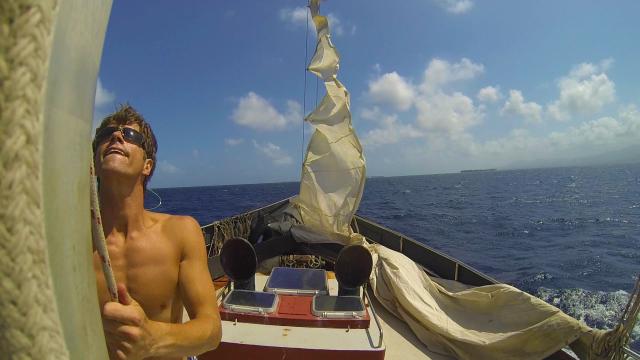Located off the coast of Panama, the Kuna Islands are rarely visited and can be dangerous to reach. So, we hopped aboard a pirate ship and set sail. Here’s how you can do that too.
When I started thinking about exploring in Panama, two girls came to mind.
The first started a rocking sushi restaurant in Bocas del Toro (Raw Fusion). The other I’d met a few years back when asking around for rock climbing suggestions in Acadia National Park to a pretty waitress in Bar Harbour, Maine. This super cool hippie chick had spent her winter in the Caribbean with some dude on a pirate ship sailing back and forth between Panama and Colombia. Sounded as close to drug running as I could imagine, and while the adventure seemed intriguing, I definitely didn’t want to end up on “Locked Up Abroad” any time soon.
I found myself calling this girl to find out if this dude was still floating around down there and whether I’d be able to spend some time aboard. Turns out, Captain Patrick Reilly isn’t a sketchy dude, just a chill Mainer who’s been spending his winters over the last 20 years living the good life with shoes off in warmer waters. He mentioned in a quick email that he’d be in the area of the San Blas islands through April, and would let us know if he was free when we were in the area.
“In the area” is a figure of speech, but pretty hard to define in this part of the world. The San Blas islands are a group of autonomously governed islands in southeastern Panama, inhabited by the Kuna Yala indigenous people. A revolution in 1924 won relative independence for the Kuna people from the government of Panama, which allowed them to continue living in their traditional way without too much outside influence, despite still formally being a part of the country.
Google maps doesn’t show any roads going to the port nearest where the boat would be, so it took quite a bit of digging around to figure out how we could make it aboard. Despite the difficulty of finding the place, he’d included a sweet friends-of-friends discount if we could wait until a couple days before we wanted to go to confirm whether he had other paying customers or not.
Given the circumstances of my half-year-long trip, I felt like I was in the prime position to be able to be flexible to take advantage of this opportunity. The plan was to come aboard his boat for a couple days, then take the newly opened Ferry Xpress across the gulf to Cartagena, Colombia, in lieu of booking a standard backpacker sailing voyage to make the crossing.
Patrick suggested this approach to us primarily because the two day crossing was a rough one in high seas, beating up wind, and a lot of the boats who make the trip have backpackers piled high and poor safety records.
The exponential increase in people sailing in the San Blas islands has in turn increased the number of shipwreck incidents: in the week of New Years 2015, five boats ran aground. Another 15 were added to that number in the same month — evidence that it is no walk in the park to navigate the reefs in this area.
The last of the shipwrecks may have been the most interesting: a young Norwegian sailing solo was making his way to Chicheme on New Years Eve amidst a nasty storm with 6m seas. The waves and current got the better of his tack around the reef windward of Chicheme, and his boat ended up rolling continuously over the reef, with him inside. Somehow, he was able to escape with his life by swimming ashore in the relatively calmer water on the inside of the reef. His boat lies perched multiple feet above sea level in the middle of the reef now, as a bleak reminder of the dangers. You sail past it, just 90m away.
A similar story from a fellow traveller surfaced months later. A friend who’s tour boat ran aground and they had to swim to shore with all of their possessions, while the captain waited on board with a gun to protect the boat from being stripped before he could arrange to get everything off. Lesson: Check out your captain’s experience and track record before signing up for anything in this area.

The adventure to get to the boat began with an overnight bus from Bocas del Toro, a no show driver for our 5am pickup in Panama City, then a four hour 4X4 ride over the mountains of central Panama after fixing the situation with Luna’s Castle staff (Luna’s Castle is an excellent resource for arrangements to San Blas).
Coast to coast to coast in 16 hours, we were fortunate enough to have a couple days’ lead time to make it there. Our final land destination was the port of Carti, which is just a couple huts for people to gather before catching the right launch to the right destination. Most of the folks there were headed to either huts on nearby islands, or meeting their boat to make the crossing to Colombia.
We were in the smaller group of folks headed for a sail, and returning to the same spot. We were so far out in the middle of nowhere here on the coast, and doing the friends-of-friends thing, we were super happy to find that the guys arranging the launches knew the boat name “Maggie”, as it had seemed no one up to this point had ever heard of it.
After watching a bunch of people get out of the water taxis with bathing suits on and packs in garbage bags, I’d guessed the ride out might get a little wet. As fortune would have it, my backpack full of electronics and I were on the leeward side of the douse, and didn’t have an issue as we pulled out of the river mouth into the open ocean. Thirty minutes eastward, we were finally at Isla Elefante and had the boat in our sights.


The 1974 steel-hulled Maggie, a 16m North Sea-style salvage from a boat yard in Maine
With such a trip just to make it to the boat, I couldn’t have been happier to step foot aboard the black, red, and yellow vessel no matter how good the sailing was going to be. Little did I know what kind of paradise we’d be heading into; our first stop was Soledad Miria, an island close to the mainland with a river-based water source piped under sea. We spent a couple hours here filling up the fresh water tanks on board, and exploring the island covered in Kuna settlement.
Our eyes were opened to their distinctive culture right away, as a circle of Kuna women brought out Mola after Mola for us to see (Molas are akin to colourful handwoven placemats that gets sown into their blouse/dress combo, sometimes made by the talented transgender Kunas). These women didn’t speak any Spanish, had native dress on including gold nose piercing and beads covering all of their lower legs. The island consisted of 1100 people living on four acres, solar panel-powered electricity and a Congreso hut where everyone gathers once a day to discuss the community matters. The afternoon began with a quick grocery run to get veggies for the coming days, and a humorous gathering of the men of the island once word got out that my Argentine travel partner Maki had asked to take a shower using the freshwater source on the dock. After realising that she was becoming the centre of attention, she changed her mind to a Nalgene style shower later in the afternoon once we were under way.
It didn’t take long for us to put the sails up, bear away from land, and really get a sense for where we were. Breeze blowing 15-20 knots constantly, the sailing was easy in the shadow of some of the more distant barrier reefs knocking down the swell. It became apparent pretty quickly how important a good eye and a current map are in this area — shallow reefs aplenty and sometimes tricky entries into the leeward side of islands where the good anchorages are located. We found that some islands indicated on the charts were no longer above water and made for more of a challenge when asserting exactly where you were.
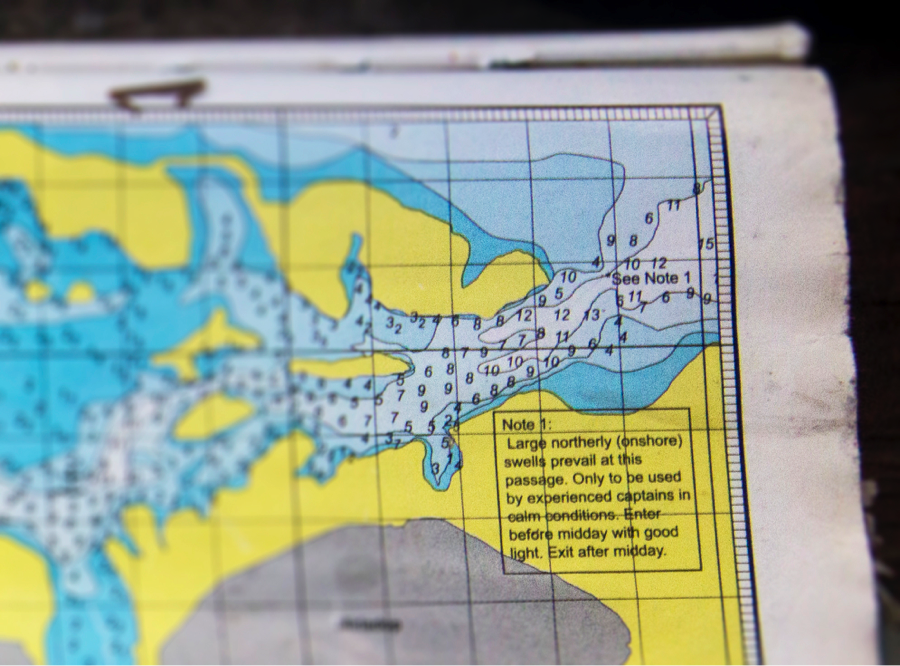
With room for six plus crew, we had plenty of room for just Maki and I and to make ourselves at home on the boat. We took the double bed in the stern with constant company from the dingy following close behind.
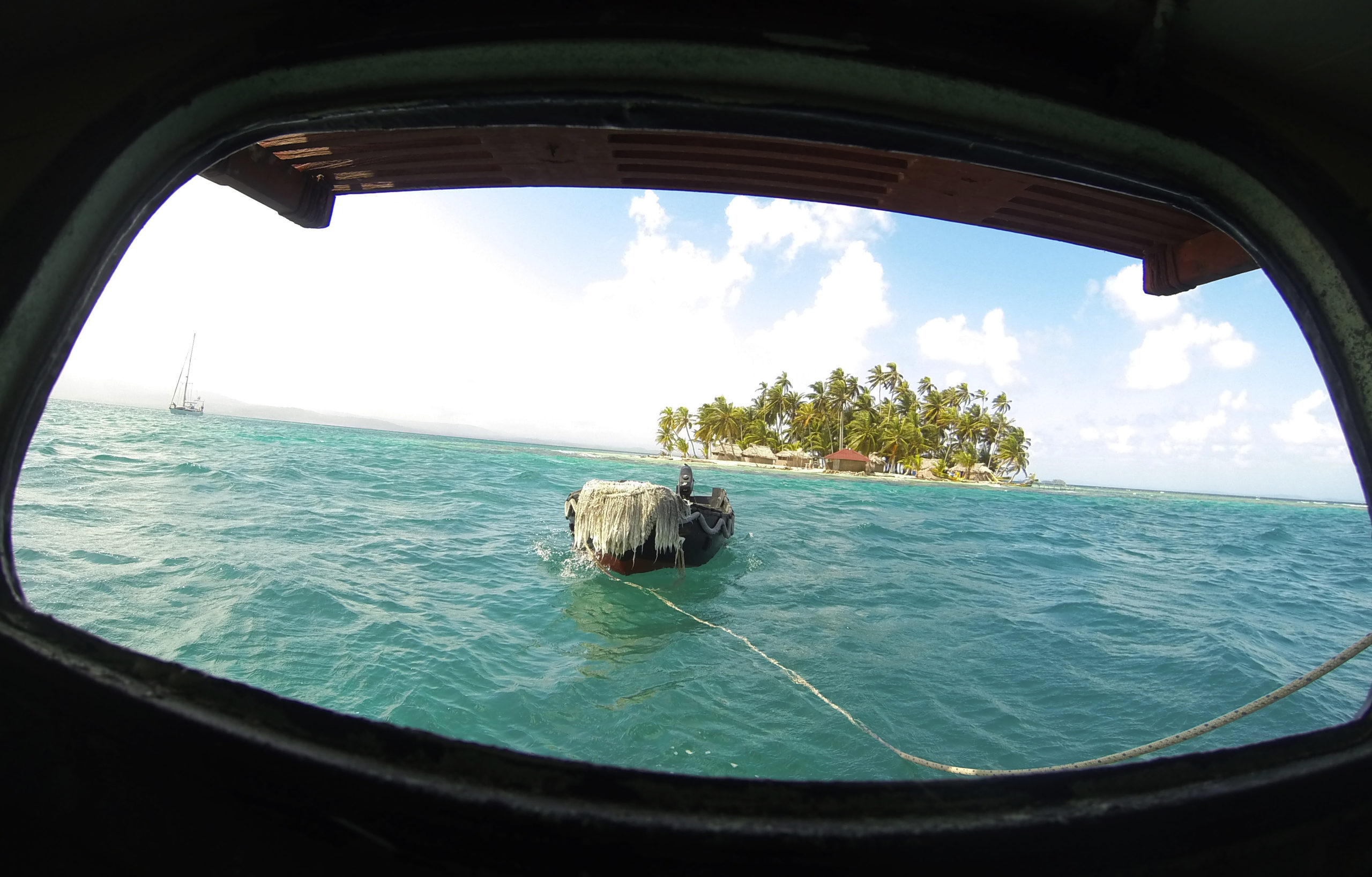
We’d been struggling to find authentic Panamanian cuisine over the prior couple of weeks, with Maki hating the fried food around every corner. Right away, we knew we were in the right spot when Patrick whipped up a bowl of island fresh fruit, some muesli and hot tea to boot. The entire time we were on board, the food was spot on, never leaving us wanting more.
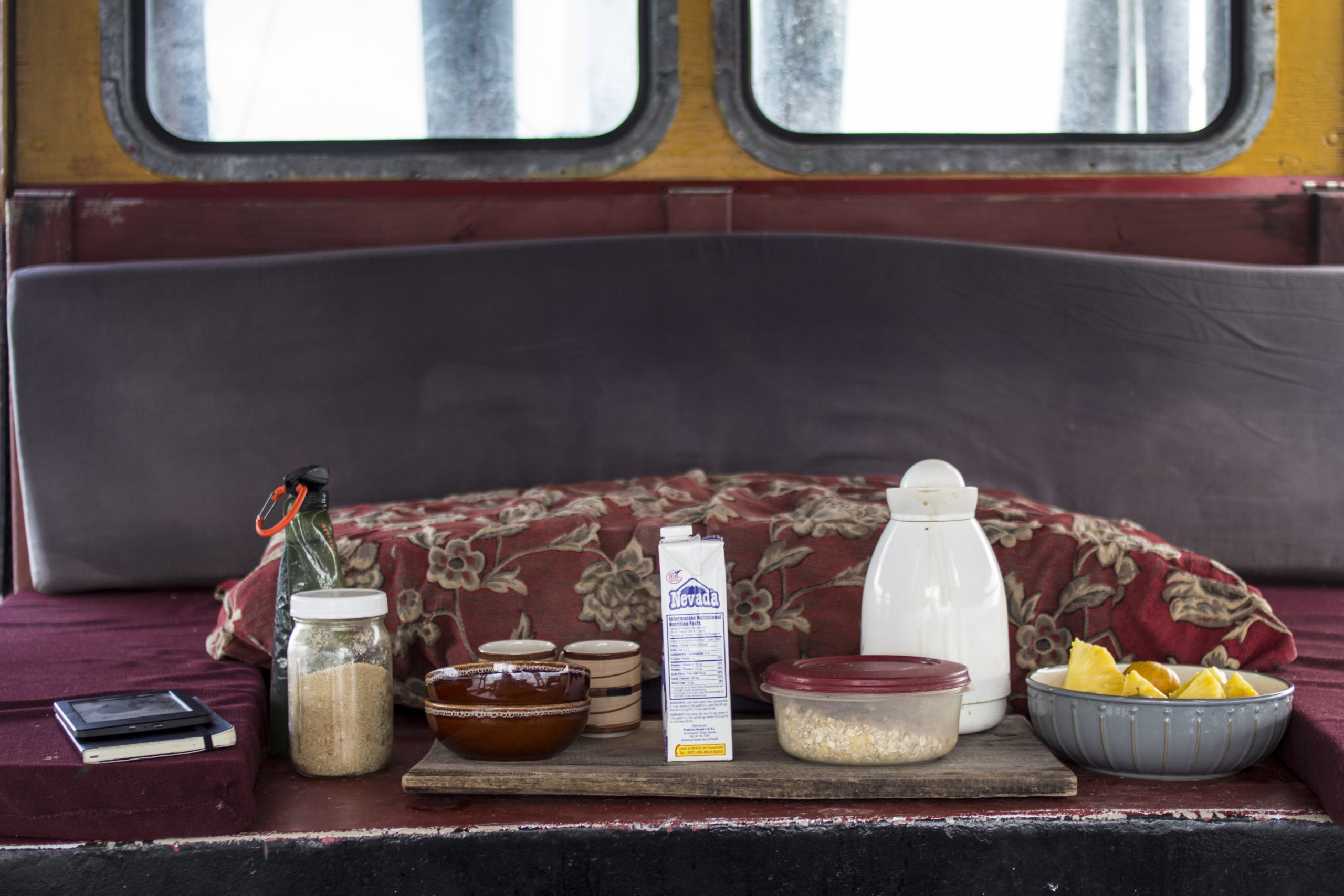
Full of calories for the day, we were free to do as we pleased. I was interested in exploring the islands a hundred yards away, but was more curious about what lay between our bow and the reefbreak nearby. Wielding some of my dad’s 20-year-old diving gear in my bag, I quickly found that the snorkel had succumbed to dry rot and I had to reach for one of Patrick’s spares.
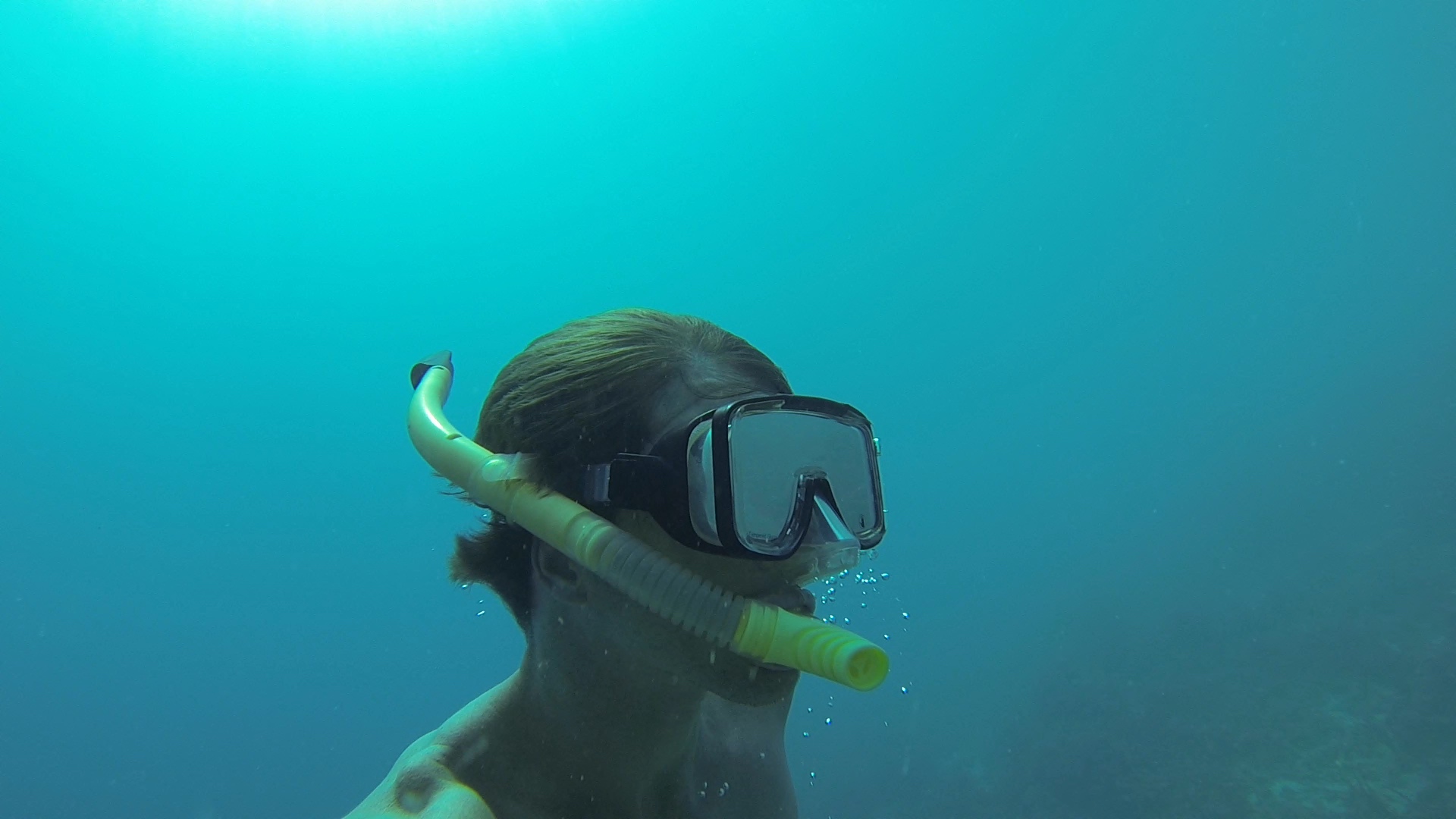
My landlubber lungs kept me above 10m, but didn’t take too much away from the exploration.
Fishing with an old Beuchat 150, spear well acquainted with oxidation and a slight bend to the right, missing one of the bands — despite the lack of pristine equipment, I could not have been happier to be on the prowl. I’d been out spearfishing with a buddy in the kelp beds of Palos Verdes in LA over the past year, but had only fished with a Hawaiian sling since I could pull the trigger on the gun setup I wanted. As it were, this would be my first legit attempt to spear my own dinner.
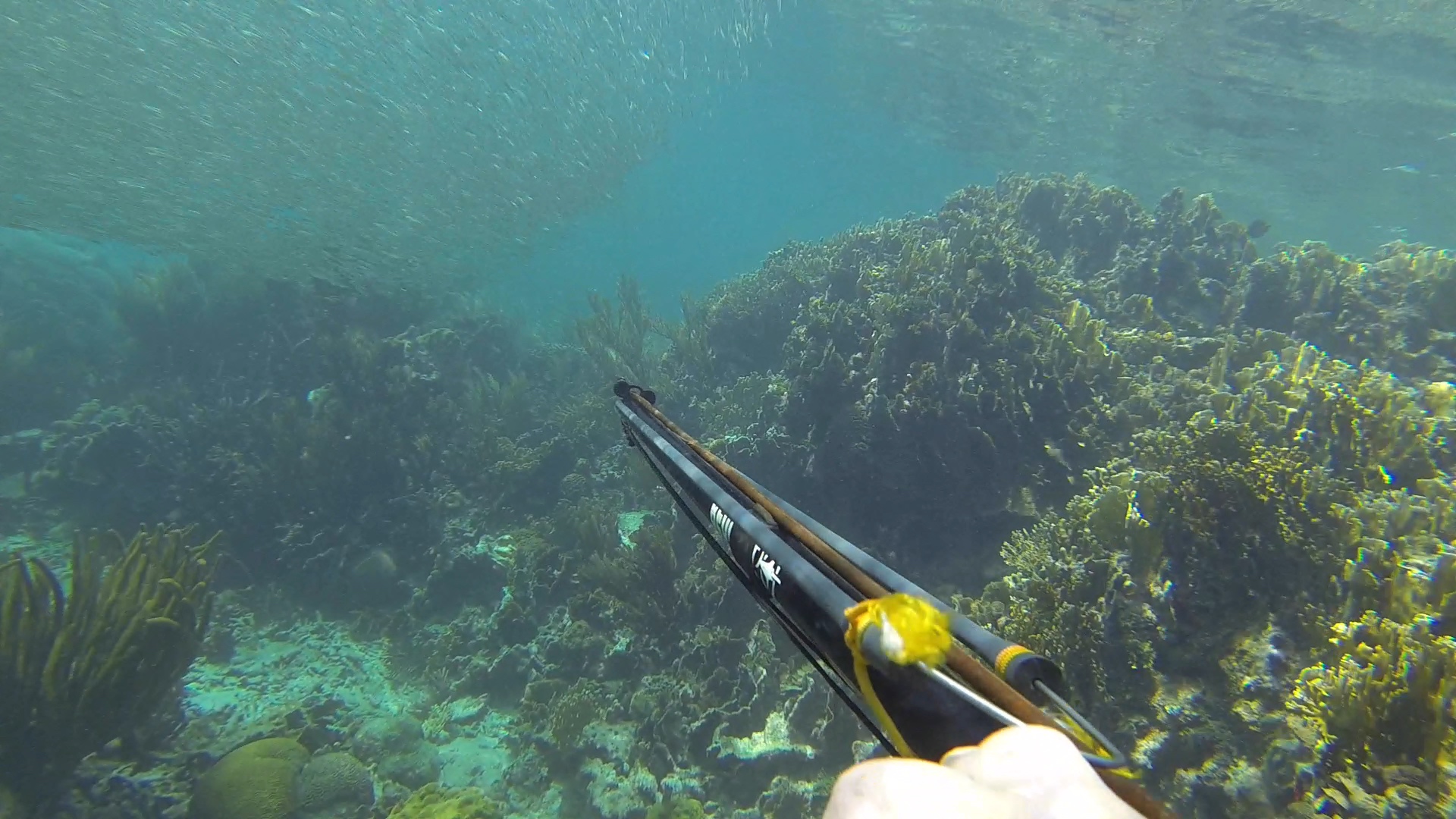
Parting the bait ball in the shallows to see if anything awaits on the other side.
I was also on the lookout for crustaceans that I wouldn’t be spearing, but would instead try to capture alive. We’d heard a few weeks before that San Blas was mecca for lobster, and were hoping to get to see what all the commotion was about. Patrick told us that the boom in visitors over the past four years had taken quite a toll on the lobster population, and the price had subsequently skyrocketed. Circa 2010, you could find yourself a clawless Caribbean lobster from a local Kuna fisherman at $US1/lobster. Fast forward to 2015, and now we’re talking $US5/lb. While I kept my eyes peeled during my time in the water, I wasn’t able to find any antennas peeking out, and found our Captain’s idiom for fishing in San Blas to be true — best way to fish in San Blas is to find a Kuna who’s already done the work.
Anchored on the windward side of the island of Waisaladup in the Western Hollandes Cays, I perused the deeper side of the reef but didn’t see a whole lot in the way of edible fish. Patrick mentioned that if I saw Lionfish, I should feel free to kill them since they’re an invasive species here and people are trying to control their population.
I was more focused on something to eat, and when a few barracuda swam by with teeth ablaze, I moved into position. The noob hunter got the best of me, and I missed my shot thanks to the safety being on. Nevertheless, I was still able to log my first catch, a Sierra, for a delicious ceviche lunch.

The noob scores some lunch! Too bad he forgot a knife or a tether to be able to clean him and continue hunting (fortunately the boat was close by).
Following lunch, I went out for another spin around the reef on the eastern side of the island and saw a few larger animals cruise by in the deep. I spied another couple barracuda and was convinced this was the best opportunity to get something for dinner, as my looks in nooks and crannies for lobster were unfruitful.
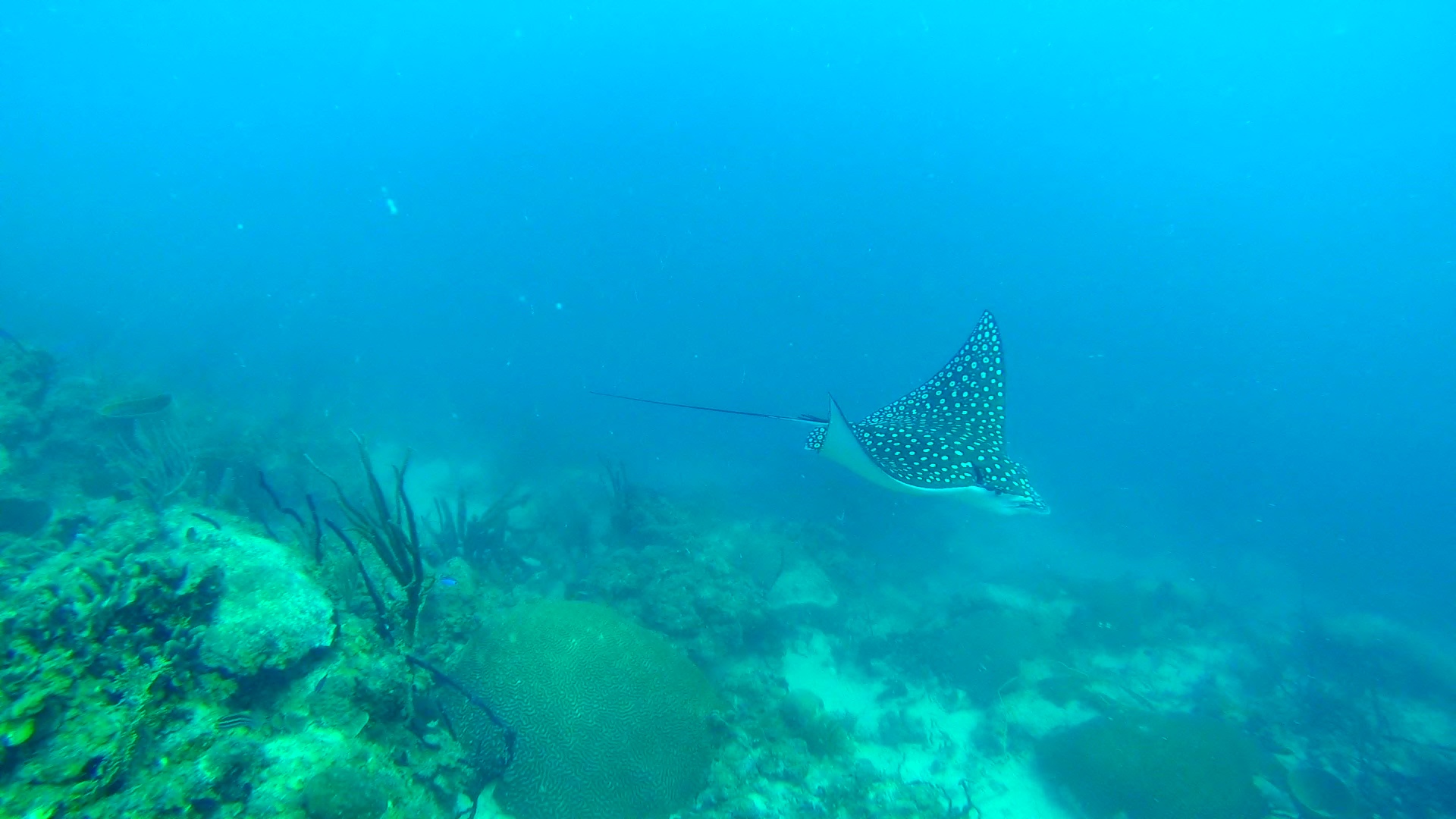
A curious Eagle ray cruises by for a closer look
Much to my surprise, I found one of the largest barracuda I’d seen hiding under a ledge in shallow water. This guy reminded me a lot of the pike I’d read about in the northern US, just a submarine of a fish, in the 100cm length range. As I slowly prepared myself for the shot, I was edging closer to his spot. I was determined to give him the stunner, after my shot on the Sierra earlier in the day was a hair too far back. He was calm, but ever so slightly moved to my left as I approached. Between the right bend in the spear, the 2.4m of woven and monofilament line reach, I figured it had to be perfect in order for this to pan out like I wanted. Unfortunately, when I pulled the trigger and sent the oxidised spike through him, his functions were good enough to exit with speed, snapping the simple knot connecting the mono to the spear and taking my hopes with him. An hour-long search for the fish turned up empty, a huge bummer for the fish and for my buddy’s spear.
After a few of the most relaxing days I’ve ever had, my appetite for living aboard a vessel was stronger than ever. The tight quarters of the beloved RV in my past had seasoned me for that of a boat, but it was the freedom of destination that the two share that really drew me in.
Patrick’s winters exploring this part of the world, even venturing up rivers to make contact with seldom-seen natives, made me green with envy. He’d picked up a lot of firsthand knowledge about the Kuna Yala, describing to us their currency once based on the coconut, with power now shifting to those families running the launches (water-taxis), as tourism is becoming the primary source of income for the region. On the last night of our stay, drinking $US1.75 beers out of a cooler at a uniquely San Blasian island bar near Chicheme, we were educated further on the rules of the land. The family running the bar was about to rotate to Waisaladup, where we just came from, to take over the coconut farming on that island for the coming months. This tradition, along with the forbiddance of strange things like kiteboarding & drinking rain water, intrigued me all the more to get out and explore the world. Fortunately, I was poised pretty well to continue doing just that.
Our transition back into the real world started with the volleyball court on Chicheme, the extent of many people’s stay in the area. Thankful to have had a few days to venture out a little further, I realised this was just a glimpse into our host’s life, where this was not an anomaly but a yearly occurrence. I’d learned a lot while on board — about caring for an old vessel, where not to shoot a fish, and how much the Panama Canal costs to cross ($US1000 for his boat, upwards of $US100,000 for the big cargo ships). Maki was a sponge while on board as well, taking the helm a few times and helping to raise the main.
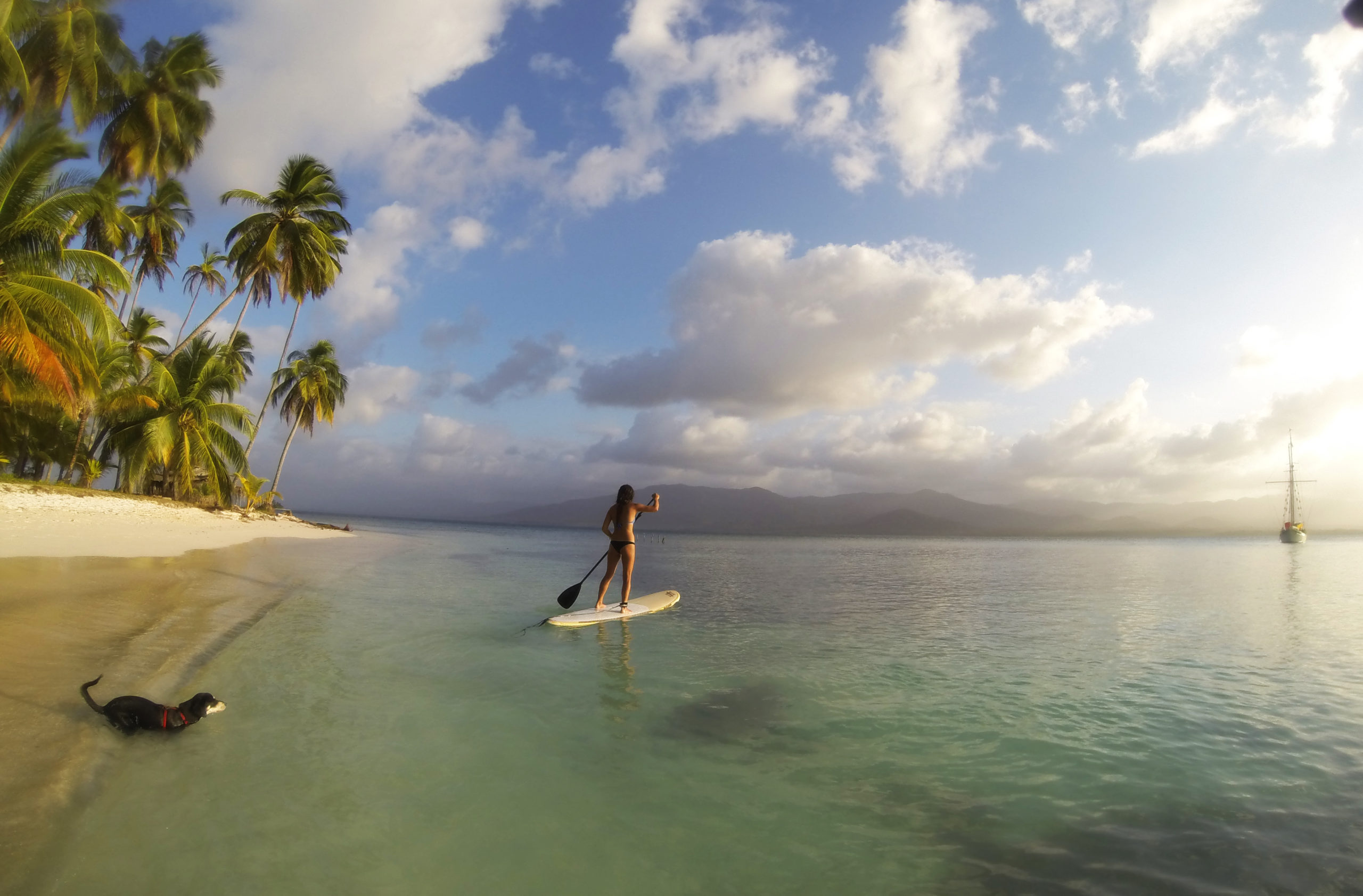
Maki learns to the paddleboard in the calm our evening anchorage, the winds helping to steer her back into the leeward side.
Want to have your own San Blas experience?
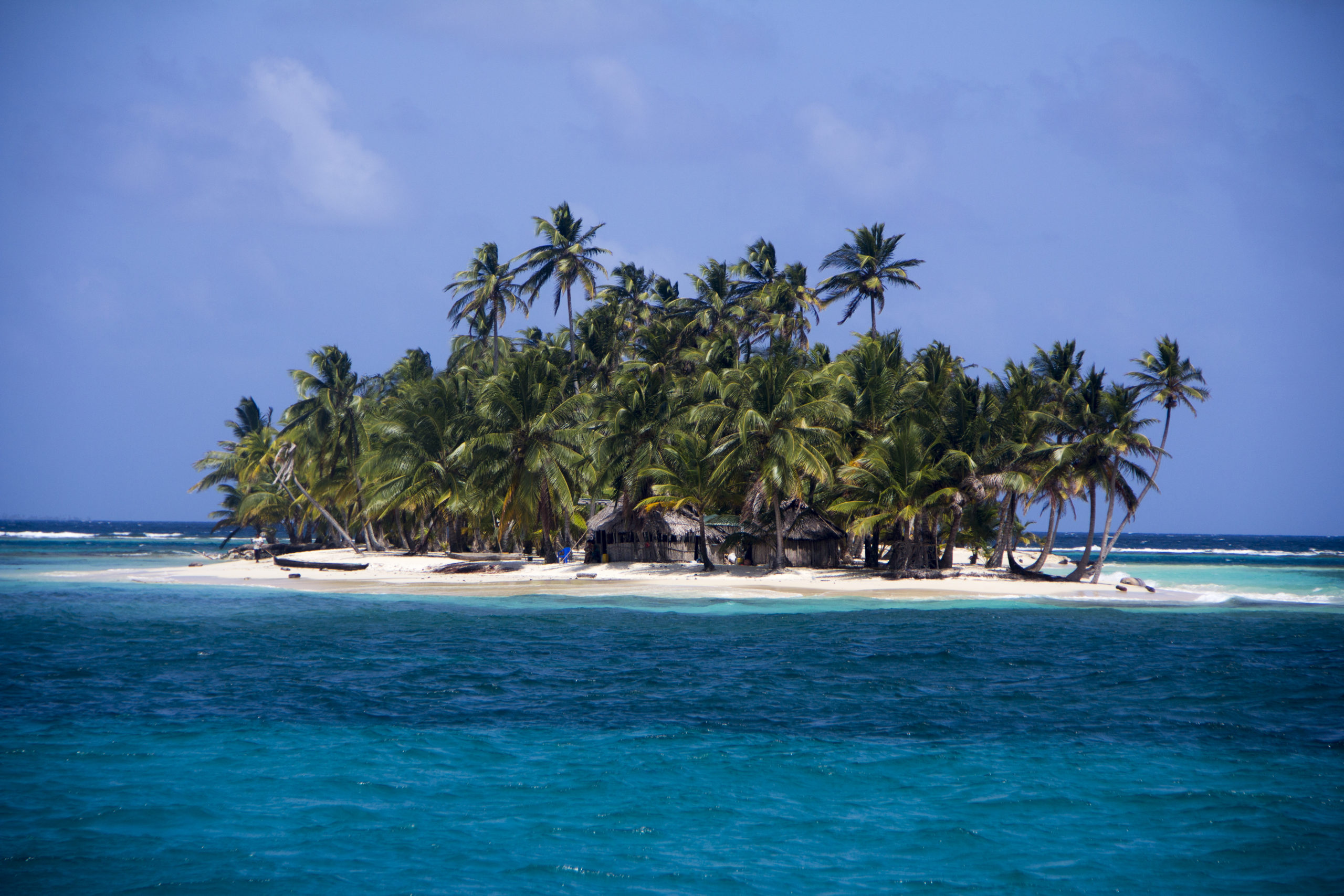
This could soon be your view through the lifelines, make it happen!
First thing to know about Panama is that it’s an incredibly travel friendly place for Americans, uses US dollars for its currency, and has friendly traveller’s insurance coverage that comes with your entry into the country. The culture shock here isn’t nearly the same as other Latin American countries, as it’s one of the most developed Spanish speaking places out there.
When honing in on the San Blas, know that it’s going to be an adventure. The most convenient jumping point is just a four-hour 4X4 ride from Panama City, now made much smoother by the newly paved road to get there. Start by looking into boats and reviews of experiences on the travel resources out there (Trip Advisor, Lonely Planet’s Thorntree forum), and the follow up with the person running the show. Don’t be surprised if the boat you read good reviews about isn’t in the area any more — after researching a strong suggestion from a friend, I found out the boat sank on a crossing to Colombia in a prior season after a junior captain made some poor decisions. Expect to shell out some cash for the trip, as this is not the easiest area to navigate and the food costs are high in the islands. No matter how long you stay, you’ll want more time; so don’t book for any less than two days in the islands.
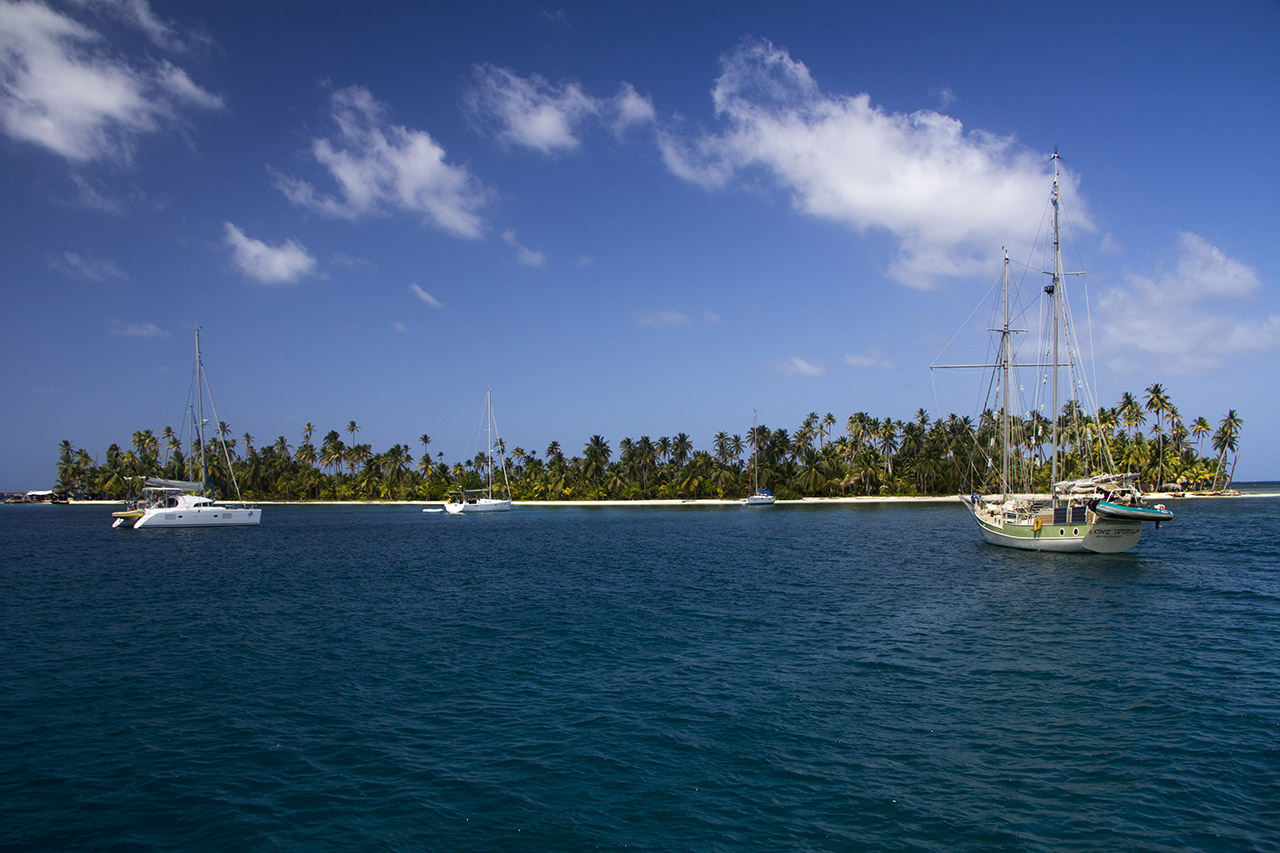
If you’re interested in making the Panama/Colombia crossing, your options are either the Ferry Xpress cruise ship or a more backpacker style sailboat. Ferry Xpress goes back and forth on certain days of the week and is a bit pricey, but the service is guaranteed. As for the backpacker boats, the crossing going from Colombia to Panama is a bit friendlier option due to the wind direction and the reward of the islands at the end of the trip. Ensure there’s amble sleeping space for the number of passengers on board, and that the captain is a cognisant, experienced chap not likely to be hitting the bottle rather than watching the tiller.
A third option is to stay on some of the closer islands in San Blas and take day trips from there. Expect the island sizes to be pretty small, so the island you camp or have your cabin on may be a bit restricting if you decide not to leave it.
Take a lot of sunscreen (buy before you leave, it’s expensive in Panama!), a mask, fins and snorkel if you have it. For those looking to spearfish, a low volume mask and some good fins are must haves. In whatever option you choose, there’s sure to be plenty of sun, cheap beer, gorgeously turquoise water and relaxation around every corner. Don’t miss out on the fresh ceviche if you can help it.
